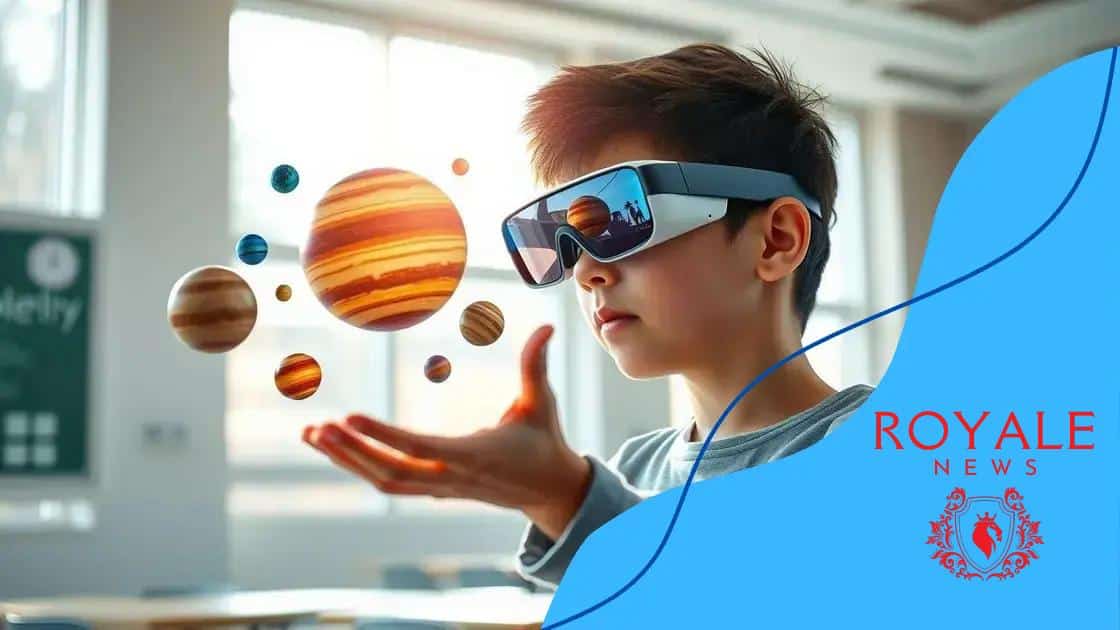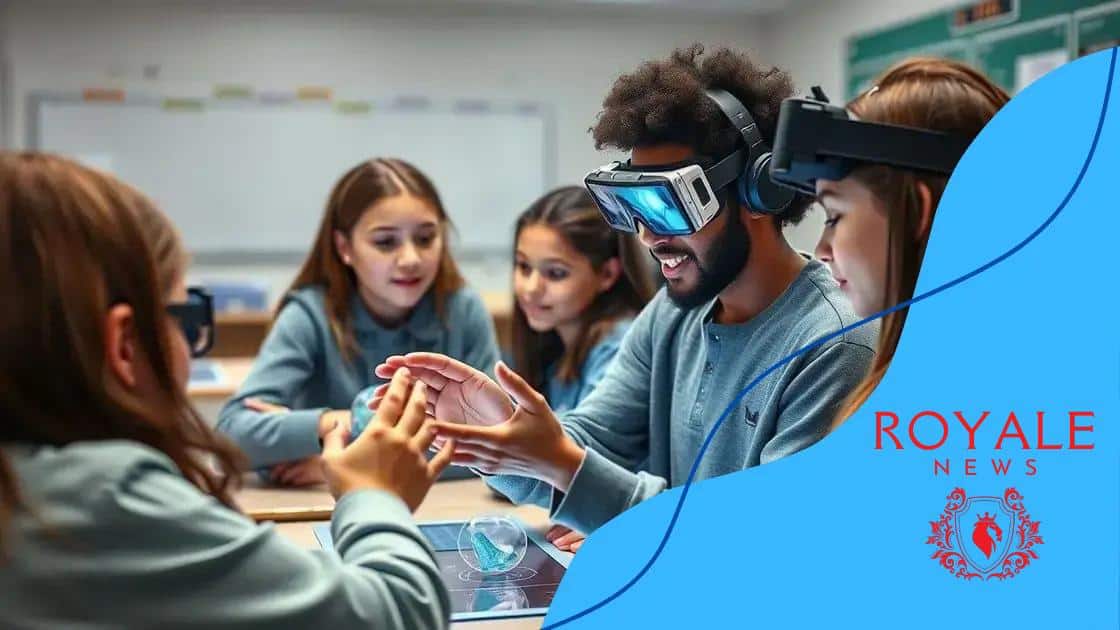How AR is being used for hands-on learning experiences

Augmented reality is revolutionizing hands-on learning experiences by enhancing engagement, facilitating personalized education, and making complex concepts more accessible through immersive interactions.
How AR is being used for hands-on learning experiences is changing the landscape of education. Imagine walking into a classroom where digital elements enhance your understanding of complex topics. Curious about how this technology can transform learning?
Understanding augmented reality in education
Understanding augmented reality (AR) in education is crucial as this technology continues to evolve. AR enhances the learning experience by overlaying digital information onto the real world. With tools like smartphones and tablets, students can interact with their environment in a unique way.
The Role of AR in Education
In the classroom, augmented reality can help visualize complex concepts. For example, students studying anatomy can use AR to see 3D models of the human body. This makes learning more engaging and interactive.
Key Applications of AR
- Field trips enhanced with AR experiences.
- Interactive textbooks that include 3D models.
- Virtual labs for science experiments.
- Historical reconstructions that students can explore.
These applications show how AR makes learning more accessible and exciting. Imagine exploring distant planets through AR, making science lessons feel like adventures.
Furthermore, teachers can tailor lessons by integrating AR into their curriculum. This customization can address various learning styles, making every student’s experience unique. Those who learn best through visual aids will especially benefit from AR’s immersive nature.
Benefits of Augmented Reality
One of the major benefits is increased engagement. Students who might struggle with traditional methods often respond better when augmented reality is involved. Additionally, AR promotes collaboration. Students can work together to solve problems, fostering teamwork.
In summary, understanding augmented reality in education open doors to innovative learning methods. This technology not only captivates but also deepens understanding, preparing students for a tech-driven future.
Real-world applications of AR for learning
Real-world applications of augmented reality (AR) for learning are expanding rapidly. This technology is being integrated into various educational settings, transforming how students interact with material. From virtual field trips to interactive lessons, AR is making learning more engaging.
Interactive Learning Experiences
One major application is in interactive learning experiences. Students can explore historical sites or distant planets without leaving the classroom. Using AR, they can visualize topics that may be hard to grasp through text alone.
Examples of AR in the Classroom
- Using AR apps to enhance textbook images, providing 3D models students can manipulate.
- Virtual labs that allow students to conduct experiments safely from their devices.
- Language learning apps that utilize AR to help students practice pronunciation and vocabulary.
- Art projects where students can visualize famous artworks in their environment.
These options highlight just a few ways augmented reality is utilized in learning. Students find joy in discovering new concepts through immersive experiences that traditional methods simply can’t match.
Moreover, schools can use AR for professional development. Teachers can be trained on new technologies or teaching methods through simulated scenarios. This hands-on approach allows them to apply what they learn immediately.
Benefits of Augmented Reality Applications
Overall, the benefits of incorporating AR into education are clear. Enhanced engagement leads to better retention of information. As students interact with 3D models or simulations, they become active participants in their learning. This shift from passive to active learning is critical in today’s educational environment.
Additionally, AR fosters collaboration among students. They can work together during AR activities, which helps build teamwork skills and improve social interactions.
Benefits of using AR in hands-on experiences

The benefits of using augmented reality (AR) in hands-on experiences are significant and diverse. This technology enhances learning by providing interactive, immersive ways for students to engage with content. By integrating AR into practical lessons, students can develop skills more effectively.
Enhanced Engagement
Firstly, AR increases student engagement. When students can interact with 3D models and simulations, they become more involved in their learning. This involvement helps maintain attention and interest, making lessons more enjoyable.
Improved Understanding
- Visualizes complex concepts in science or math.
- Allows exploration of historical events in an interactive way.
- Facilitates better learning of anatomy through 3D models.
- Encourages creativity in art and design classes.
Understanding difficult topics becomes easier when students can visualize them in a tangible way. For example, learning about the solar system through a 3D AR model allows students to see the scale and position of planets in real-time. This kind of visualization makes abstract concepts concrete, aiding retention.
Additionally, using AR promotes collaboration among students. They can work together on projects, enhancing teamwork and communication skills. Collaborative learning experiences can lead to better outcomes, as students learn from each other and share their discoveries.
Real-World Applications
Moreover, augmented reality provides opportunities for real-world applications. Students can practice skills in a safe environment before applying them in real situations. For instance, medical students can use AR to simulate surgeries, gaining practical experience without risks.
Furthermore, AR can cater to different learning styles. Visual learners benefit from seeing models, while kinesthetic learners engage by interacting with digital elements. This adaptability makes AR a powerful tool in diverse classrooms where students have various needs.
Challenges and considerations in AR implementation
Challenges and considerations in AR implementation are important topics for educators and institutions. While augmented reality offers exciting possibilities, there are hurdles that need to be addressed to harness its full potential.
Technical Limitations
One challenge is the technical limitations of AR tools. Schools may face issues with outdated devices or inadequate software. Not all students have access to smartphones or tablets, which can create disparities in learning opportunities. Additionally, some AR applications require strong internet connectivity, and not every area has reliable access.
Cost of Implementation
- Budget constraints may limit access to quality AR resources.
- Training teachers to use AR technology effectively can be costly.
- Subscription fees for AR apps can add up over time.
Cost is another challenging factor. Implementing AR technology requires investment in both hardware and software. Schools may struggle to find funding for these resources, especially if they need to upgrade existing technology.
Additionally, schools need to consider the training of staff. Teachers must be properly trained to use AR tools effectively in the classroom. If they are not comfortable with the technology, it can hinder student learning.
Content Quality and Preparation
Another consideration is the quality of AR content. Not all AR experiences are created equal. Educators need to vet applications carefully to ensure they provide accurate and valuable information. Poorly designed content may lead to confusion and disengagement among students.
Moreover, integrating augmented reality into the curriculum can feel overwhelming. Teachers may struggle to find ways to incorporate these tools effectively while still meeting state standards. This balancing act can cause stress and uncertainty.
Lastly, ensuring that AR applications are user-friendly is vital. Complicated interfaces can frustrate both teachers and students, potentially reducing the effectiveness of the learning tool.
Future trends in AR for education
Future trends in AR for education are promising and innovative. As technology advances, the possibilities for augmented reality in learning environments continue to grow. Educators are excited about what is to come, as these trends can enhance students’ educational experiences.
Increased Accessibility
One major trend is the increase in accessibility to AR tools. With the rise of budget-friendly apps and devices, more students can engage in augmented reality learning experiences. This accessibility will help to bridge the gap between different socioeconomic backgrounds.
Enhanced Personalization
- AR technology will allow for customized learning paths.
- Students can learn at their own pace, reinforcing concepts they find challenging.
- Interactive assessments will adapt based on individual performance.
Another trend is enhanced personalization. As AR tools begin to utilize artificial intelligence, they can tailor lessons for each student. This means that learning experiences will be more focused on the student’s needs, making education more effective.
Moreover, we will see a wider application of AR in various subjects. Beyond science and history, subjects like language and the arts will incorporate augmented reality to create immersive learning environments. For example, students learning a new language can interact with AR elements that help them practice vocabulary in real situations.
Collaboration with Virtual Reality (VR)
Future developments may also see AR integrating more with virtual reality (VR). This combination could create fully immersive classroom environments where students can explore and interact in 3D worlds. For instance, combined AR and VR could allow students to take virtual field trips to historical sites or outer space while completing interactive assignments.
Furthermore, the global shift to online learning opens doors for AR to enhance virtual classrooms. With the use of AR, teachers can create engaging content even in remote setups, fostering interaction among students who may never meet in person.
FAQ – Frequently Asked Questions about Augmented Reality in Education
What are the main benefits of using augmented reality in education?
The main benefits include increased engagement, enhanced understanding of complex topics, and improved collaboration among students.
How can augmented reality personalize learning experiences?
Augmented reality allows for tailored lessons that cater to individual student needs, helping them learn at their own pace.
What challenges do schools face when implementing AR technology?
Challenges include limited access to devices, high costs of software, and the need for teacher training on effective AR use.
What future trends can we expect in AR for education?
Future trends include increased accessibility, integration with virtual reality, and a broader application of AR across various subjects.





